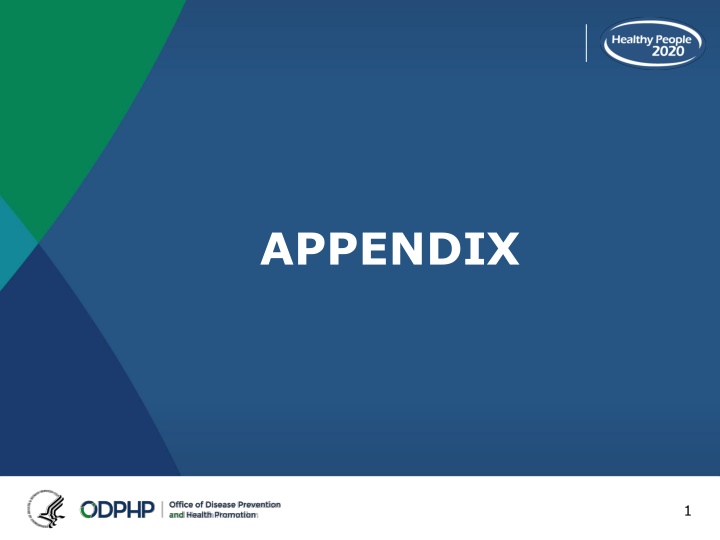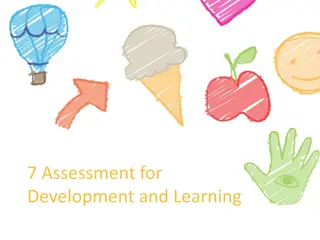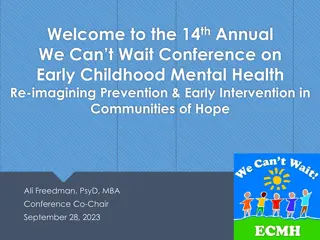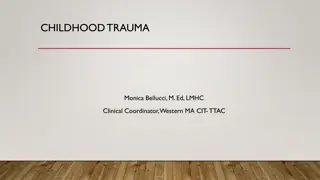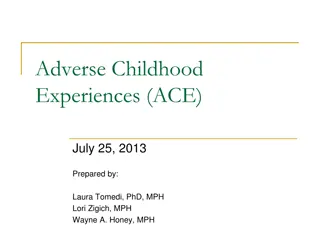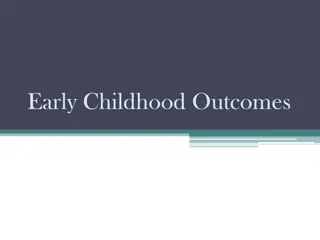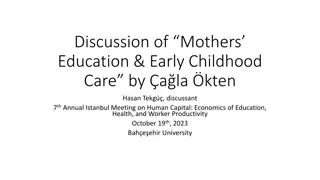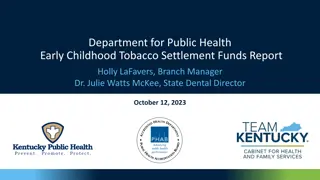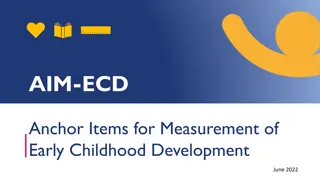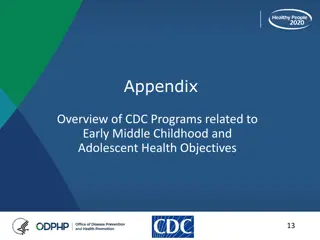Early Childhood Development Goals and Progress
The document outlines specific objectives to enhance early childhood development, including improvements in school readiness, positive parenting practices, sleep quality, and health education requirements across different school levels. It also addresses the diagnosis and treatment of ADHD in children.
Download Presentation

Please find below an Image/Link to download the presentation.
The content on the website is provided AS IS for your information and personal use only. It may not be sold, licensed, or shared on other websites without obtaining consent from the author.If you encounter any issues during the download, it is possible that the publisher has removed the file from their server.
You are allowed to download the files provided on this website for personal or commercial use, subject to the condition that they are used lawfully. All files are the property of their respective owners.
The content on the website is provided AS IS for your information and personal use only. It may not be sold, licensed, or shared on other websites without obtaining consent from the author.
E N D
Presentation Transcript
APPENDIX 1
Objective Status: Early and Middle Childhood Target met Improving Little/No change Getting worse Baseline only Developmental EMC-1 (Developmental) Increase the proportion of children who are ready for school in all five domains of healthy development: physical development, social-emotional development, approaches to learning, language, and cognitive development EMC-2.2 Increase the proportion of parents who use positive communication with their child EMC-2.3 Increase the proportion of parents who read to their young child EMC-2.4 Increase the proportion of parents who receive information from their doctors or other health care professionals when they have a concern about their children s learning, development, or behavior EMC-3 (Developmental) Reduce the proportion of children who have poor quality of sleep EMC-4.1.1 Increase the proportion of elementary schools that require newly hired staff who teach required health education to have undergraduate or graduate training in health education EMC-4.1.2 Increase the proportion of middle schools that require newly hired staff who teach required health education to have undergraduate or graduate training in health education EMC-4.1.3 Increase the proportion of high schools that require newly hired staff who teach required health education to have undergraduate or graduate training in health education EMC-4.2.1 Increase the proportion of elementary schools that require newly hired staff who teach required health instruction to be certified, licensed, or endorsed by the State in health education
Objective Status: Early and Middle Childhood Target met Improving Little/No change Getting worse Baseline only Developmental EMC-4.2.2 Increase the proportion of middle schools that require newly hired staff who teach required health instruction to be certified, licensed, or endorsed by the State in health education EMC-4.2.3 Increase the proportion of high schools that require newly hired staff who teach required health instruction to be certified, licensed, or endorsed by the State in health education EMC-4.3.1 Increase the proportion of elementary schools that require cumulative instruction in health education that meet the US National Health Education Standards for elementary, middle, and senior high schools EMC-4.3.2 Increase the proportion of middle schools that require cumulative instruction in health education that meet the US National Health Education Standards for elementary, middle, and senior high schools EMC-4.3.3 Increase the proportion of high schools that require cumulative instruction in health education that meet the US National Health Education Standards for elementary, middle, and senior high schools EMC-4.4 Increase the proportion of required health education classes or courses with a teacher who has had professional development related to teaching personal and social skills for behavior change within the past 2 years EMC-5.1 (Developmental) Increase the proportion of children aged 4-5 years diagnosed with ADHD who receive recommended behavioral treatment EMC-5.2 (Developmental) Increase the proportion of children aged 6-17 years diagnosed with ADHD who receive recommended behavioral treatment, medication treatment, or both
Current HP2020 Objective Status: Early and Middle Childhood Measurable objectives: 13 Total objectives: 19 Improving 7.7% (n = 1) Getting worse 23.1% (n = 3) Measurable 68.4% (n = 13) Developmental 21.1% (n = 4) Little or no detectable change 69.2% (n = 9) Archived 10.5% (n = 2)
Positive Parenting: Children With Special Health Care Needs, 2011 2012 Children With Special Health Care Needs Children Without Special Health Care Needs Percent 100 HP2020 Target: 76.8% HP2020 Target: 52.8% 80 HP2020 Target: 52.6% 60 40 20 0 Communication between child and parent (Ages 6 17 Years) Young children who are read to everyday (Ages 0 5 Years) Developmental inquiry from doctor (Ages 0 5 Years) NOTES: I= 95% confidence interval. Children with special health care needs are identified by parents' reports that their child has a health problem expected to last at least 12 months and which requires prescription medication, more services than most children, special therapies, or which limits their child's ability to do things most children can do. Data for communication between child and parent are for children aged 6 to 17 years whose parents reported they could share ideas and talk with them about things that mattered very well . Data for young children who are read to everyday are for children aged 0 to 5 years whose parents reported that someone in their family read to the child every day in the past week. Data for developmental advice from doctor are for children aged 0 to 5 years who visited or used a health service in the past 12 months and whose parents reported that their child s doctor or other health professional gave them specific information to address their concerns about the child s learning, development, or behavior. 5 Objs. EMC-2.2 EMC-2.4 Increase desired SOURCE: National Survey of Children s Health (NSCH), HRSA/MCHB and CDC/NCHS.
School Health Educator Requirements: Training for Newly Hired Staff, 2006 and 2014 *2006 2014 Percent 100 HP2020 Target: 84.5% 80 HP2020 Target: 62.6% 60 HP2020 Target: 38.7% 40 20 0 Elementary School Middle and Junior High School High School School Level NOTES: I = 95% confidence interval. *2006 = HP2020 baseline. Data for training for newly hired staff are for schools that require newly hired staff who teach required health education to have undergraduate or graduate training in health education. 6 Objs. EMC-4.1.1 EMC-4.1.3 Increase desired SOURCE: School Health Policies and Practices Study (SHPPS), CDC/NCHHSTP.
School Health Educator Requirements: Certification for Newly Hired Staff, 2006 and 2014 *2006 2014 Percent 100 HP2020 Target: 80.1% 80 HP2020 Target: 55.8% 60 HP2020 Target: 35.8% 40 20 0 Elementary School Middle and Junior High School High School School Level NOTES: I = 95% confidence interval. *2006 = HP2020 baseline. Data for certification for newly hired staff are for schools that require newly hired staff who teach required health education topics to have certification in health education. 7 SOURCE: School Health Policies and Practices Study (SHPPS), CDC/NCHHSTP. Objs. EMC-4.2.1 EMC-4.2.3 Increase desired
School Health Education Requirements: Cumulative Instruction Time, 2006 and 2014 *2006 2014 Percent 100 80 60 40 HP2020 Target: 14.3% HP2020 Target: 10.5% HP2020 Target: 11.5% 20 0 Elementary School Middle and Junior High School High School School Level NOTES: I = 95% confidence interval. *2006 = HP2020 baseline. Data for cumulative instruction time are for schools that require cumulative instruction in health education that meet national standards for cumulative time. The US National Health Education Standards are: 360 hours for Elementary Schools, 240 hours for Middle Schools, and 320 hours for High Schools. 8 Objs. EMC-4.3.1 EMC-4.3.3 Increase desired SOURCE: School Health Policies and Practices Study (SHPPS), CDC/NCHHSTP.
School Health Educator Requirements: Professional Development for Behavior Change, 2006 and 2014 *2006 2014 Percent 100 80 HP2020 Target: 57.8% 60 40 20 0 Health Education Classes NOTES: I = 95% confidence interval. *2006 = HP2020 baseline. Data are for health education classes taught by a teacher who has had professional development related to teaching skills for behavior change in the past 2 years. 9 Obj. EMC-4.4 Increase desired SOURCE: School Health Policies and Practices Study (SHPPS), CDC/NCHHSTP.
Objective Status: Adolescent Health Target met Improving Little/No change Getting worse Baseline only Developmental AH-1 Increase the proportion of adolescents who have had a wellness checkup in the past 12 months AH-2 Increase the proportion of adolescents who participate in extracurricular and/or out-of-school activities AH-3.1 Increase the proportion of adolescents who have an adult in their lives with whom they can talk AH-3.2 Increase the proportion of parents who attend events and activities in which their adolescents participate AH-4.1 Increase the proportion of adolescents in foster care who exhibit positive early indicators of readiness for transition to adulthood AH-5.1 Increase the proportion of students who graduate with a regular diploma 4 years after starting 9th grade AH-5.2 Increase the proportion of students who are served under the Individuals with Disabilities Education Act who graduate high school with a diploma AH-5.3.1 Increase the proportion of 4th grade students whose reading skills are at or above the proficient achievement level for their grade AH-5.3.2Increase the proportion of 8th grade students whose reading skills are at or above the proficient achievement level for their grade AH-5.3.3 Increase the proportion of 12th grade students whose reading skills are at or above the proficient achievement level for their grade
Objective Status: Adolescent Health - Continued Target met Improving Little/No change Getting worse Baseline only Developmental AH-5.4.1 Increase the proportion of 4th grade students whose mathematics skills are at or above the proficient achievement level for their grade AH-5.4.2 Increase the proportion of 8th grade students whose mathematics skills are at or above the proficient achievement level for their grade AH-5.4.3 Increase the proportion of 12th grade students whose mathematics skills are at or above the proficient achievement level for their grade AH-5.5 Increase the proportion of adolescents who consider their school work to be meaningful and important AH-5.6 Decrease school absenteeism among adolescents due to illness or injury AH-6 Increase the proportion of schools with a school breakfast program AH-7 Reduce the proportion of adolescents who have been offered, sold, or given an illegal drug on school property AH-8 Increase the proportion of adolescents whose parents consider them to be safe at school AH-9 Increase the proportion of middle and high schools that prohibit harassment based on a student s sexual orientation or gender identity AH-10 Reduce the proportion of public schools with a serious violent incident
Objective Status: Adolescent Health - Continued Target met Improving Little/No change Getting worse Baseline only Developmental AH-11.1 Reduce the rate of minor and young adult perpetration of violent crimes AH-11.2 Reduce the rate of minor and young adult perpetration of serious property crimes AH-11.3 Decrease the proportion of secondary school students who report the presence of youth gangs at school during the school year AH-11.4 Reduce the rate of adolescent and young adult victimization from crimes of violence
Current HP2020 Objective Status: Adolescent Health Measurable objectives: 24 Baseline Only 8.3% (n = 2) Little or no detectable change 20.8% (n = 5) Target met or exceeded 33.3% (n = 8) Measurable 100% (n= 24) Improving 37.5% (n = 9)
Adolescent Wellness Checkup, 2008 and 2016 *2008 2016 Percent HP2020 Target: 75.6% 100 80 60 40 20 0 Total American Indian or Alaska Native Asian Hispanic Black White Non-Hispanic Non-Hispanic Race/Ethnicity NOTES: I = 95% confidence interval. *2008 = HP2020 baseline. Data are for adolescents aged 10 to 17 years who received a wellness checkup during the past 12 months when not sick or injured. Persons of Hispanic origin may be or any race. 14 SOURCE: National Health Interview Survey (NHIS), CDC/NCHS. Obj. AH-1 Increase desired
Participation in Extracurricular Activities, 2011 2012 Adolescents With Special Health Care Needs Adolescents Without Special Health Care Needs Percent 100 HP2020 Target: 90.6% 80 60 40 20 0 NOTES: I = 95% confidence interval. Adolescents with special health care needs are identified by parents' reports that their child has a health problem expected to last at least 12 months and which requires prescription medication, more services than most children, special therapies, or which limits their child's ability to do things most children can do. Data are for adolescents aged 12 to 17 years participating in one or more organized extracurricular and/or out-of-school activities in the past 12 months including: 1. being on a sports team or taking sports lessons after school or on weekends; 2. participating in any clubs or organizations after school or on weekends; 3. participating in any other organized events or activities. 15 Obj. AH-2 Increase desired SOURCE: National Survey of Children s Health (NSCH), HRSA/MCHB and CDC/NCHS.
Defining Achievement Levels Achievement levels. Performance standards set by the National Assessment Governing Board that provide a context for interpreting student performance on NAEP, based on recommendations from panels of educators and members of the public. The levels, basic, proficient, and advanced, measure what students should know and be able to do at each grade assessed. See each NAEP subject for a detailed description of what students should know and be able to do at each level at grade 4, 8, or 12. Source: National Assessment of Educational Progress (NAEP), ED/NCES. https://nces.ed.gov/nationsreportcard/glossary.aspx#scale_score 16 Objs. AH-5.3.2 & AH-5.4.2 Increase desired
Defining Basic, Proficient and Advanced Achievement Levels Basic. Denotes partial mastery of prerequisite knowledge and skills that are fundamental for proficient work at each grade assessed. Proficient: Represents solid academic performance for each grade assessed. Students reaching this level have demonstrated competency over challenging subject matter, including subject-matter knowledge, application of such knowledge to real-world situations, and analytical skills appropriate to the subject matter. Advanced. Refers to superior performance at each grade assessed. Source: National Assessment of Educational Progress (NAEP), ED/NCES. https://nces.ed.gov/nationsreportcard/glossary.aspx#scale_score 17 Objs. AH-5.3.2 & AH-5.4.2 Increase desired
On-Time High School Graduation, 2014-15 Healthy People 2020 Objective AH-5.1 National Target = 87% National Rate = 83% WA ME MT ND MN VT OR NH MA ID WI SD NY CT MI WY RI IA PA NE NJ OH NV MD IN DE UT IL DC WV CO CA VA KS MO KY NC TN Percent OK AZ AR NM SC 69 - 74 75 - 81 82 - 86 87 - 91 AL GA MS TX LA AK States shown in green met the national target. FL HI NOTES: Data are for public high school students who graduated with a regular diploma 4 years after starting 9th grade the first time and are measured using the 4-year adjusted cohort graduation rate. There are some differences in how states implemented the requirements for the ACGR, leading to the potential for differences across states in how the rates are calculated. Data are displayed by a modified Jenks classification for states. For more information see National Center for Health Statistics. Appendix A: Technical Notes. Healthy People 2020 Midcourse Review. Hyattsville, MD. 2016. https://www.cdc.gov/nchs/data/hpdata2020/HP2020MCR-D01-Technical-Notes.pdf SOURCE: Common Core of Data (CCD), ED/NCES. 18 Obj. AH-5.1 Increase desired
High School Graduation of Students Served Under the IDEA, 2007 2008 and 2014 2015 *2007 2008 2014 2015 Percent HP2020 Target: 65.0% 80 60 40 20 0 Multiple Emotional Disturbance Intellectual Speech/ Language Deaf/ Blind Hearing Orthopedic Other Specific Learning Traumatic Brain Injury Autism Total Visual Impairments Disabilities NOTES: *2007 2008 = HP2020 baseline. Data are for students aged 14 to 21 years served under the Individuals with Disabilities Education Act (IDEA), Part B, who graduated from high school with a diploma. 19 SOURCE: Individuals with Disabilities Education Act data (IDEA data), ED/OSERS. Obj. AH-5.2 Increase desired
Perpetration of Violent Crimes, 2008, 2010, and 2012 Rate per 100,000 800 *2008 2010 2012 600 HP2020 Target: 399.6 400 200 0 Total Male Female 10-17 18-24 Sex Age (years) NOTES: *2008 = HP2020 baseline. Data are for arrests of juveniles aged 10 to 17 years and young adults aged 18 to 24 years for crimes included in the Violent Crime Index (murder and non-negligent manslaughter, forcible rape, and aggravated assault). SOURCE: Uniform Crime Reporting Program (UCR), DOJ/FBI. 20 Obj. AH-11.1 Decrease desired
